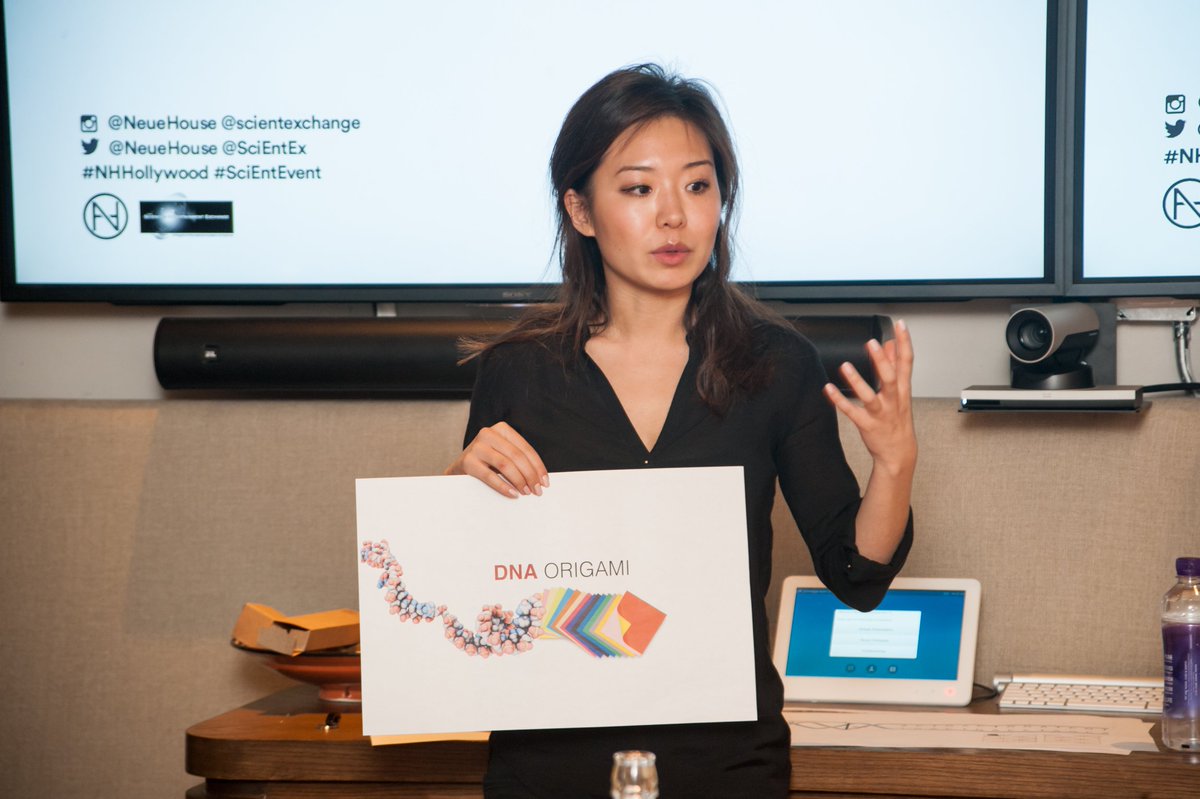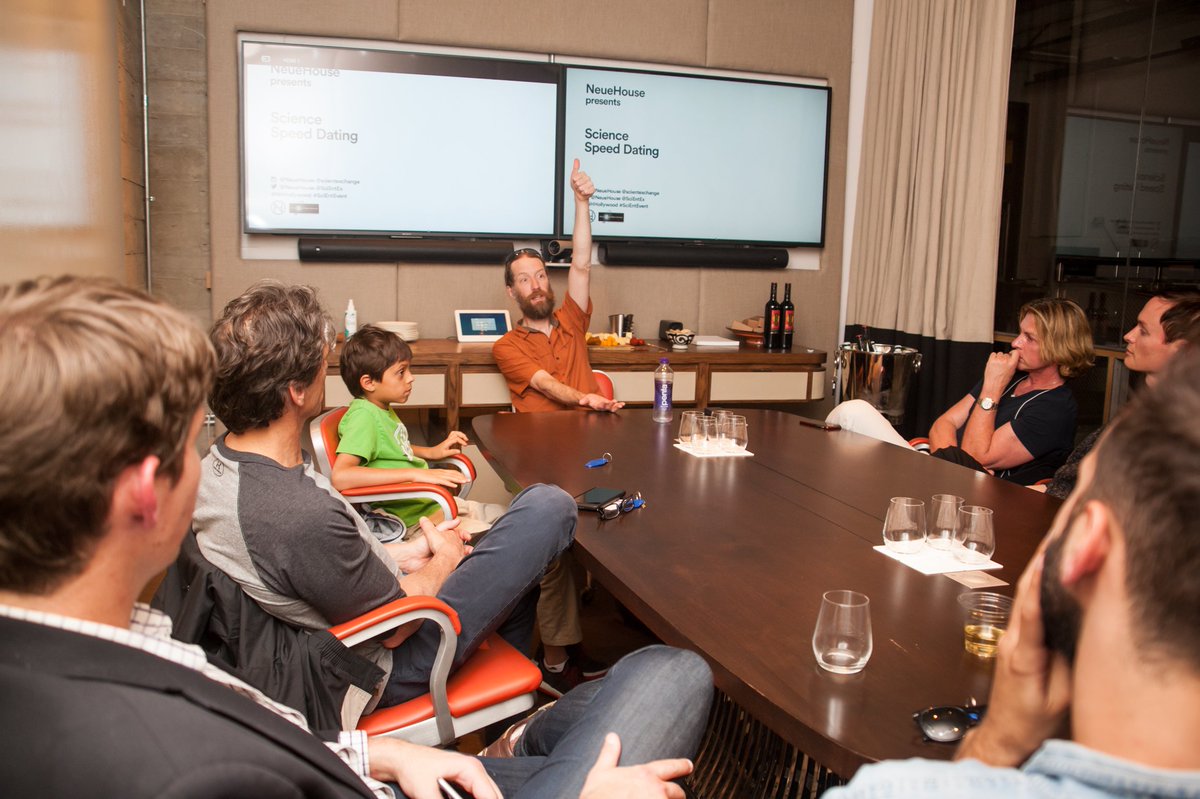
Merry Wang, Autodesk (photo credit: Steve Lucero / BFA)
“The future is cool. Don’t let anyone scare you into thinking otherwise.”
—John Rogers
“Multiply seven times seven. Take 49 steps right up to seventh heaven.”
—Schoolhouse Rock
I had never attended one of The Science & Entertainment Exchange’s famous round-robin talks and did not know what to expect. This week, I joined the organization in their sexy new digs at Neuehouse Hollywood (“international first-class travel lounge meets office—on crack”) as a speed-dating virgin and left with my mind properly blown.
After a welcoming wine and cheese reception, we (the Hollywood types, that is) were each given a mysterious key, which in turn linked us to a handler that ushered small groups into seven rooms. The evening consisted of seven world-class scientists, each pitching the essence of their cutting-edge research, in a seven-minute time frame. Lather-rinse-repeat, you guessed it, seven times. A numerologist’s (or Mason’s) dream come true.
There wasn’t really a theme to the seven presentations—other than perhaps the fact that there wasn’t a theme. This was an utter celebration of the diversity of scientific thought.
First up was Noelle Aly, a bioengineer and a Ph.D. student at the Icahn School of Medicine at Mount Sinai. Her research interests include 3D printing, lab on a chip microfluidic devices, and tissue and organ culture. She also teaches science to kids and brings art and creativity to STEM.
Noelle is a pioneer in the field of 3D bioprinting, which involves constructing an armature upon which living stem cells can grow on a nanoscale level into a fully functional organ. Yup, in a matter of days you can print a blood vessel. Or an ear. It’s still in its early days, but already they have been able to reverse conditions like paralysis in rats.
And lest we think it’s all about saving the world, these days just about any biological material is printable. Reminiscent of the scary auto-food in Star Trek: The Original Series, Costco is now beginning to print 3D meat.
On that appetizing note, Noelle ceded the stage to Merry Wang, senior research scientist at Autodesk Research. Her focus within the Bio/Nano Research Group is on cloud-based tools for 3D molecular visualization and the design of nanoscale biological structures.
What, you might (and should) ask, does that mean? Essentially, Merry is a world-class designer who uses DNA as her construction material. On a nanoscale, she designs and builds structures that can operate inside the human body. One example is a DNA “box” that contains chemotherapy drugs but does not open until it encounters a cancer cell, thus reducing the side effects to the rest of the body.
Keeping with the medical side of things, we then heard from Dean Sherzai, director of the Brain Health and Alzheimer’s Prevention Program at Cedars-Sinai Medical Center and Afghanistan’s former Deputy Minister of Health. His research interest is in preventive neurology and he has a personal interest in the neuroscience of motivation and leadership.
From Dean we learned about the serious and growing risk of Alzheimer’s disease, which for little-understood reasons is growing fast and is so expensive to treat that it threatens to collapse our health care system in a few decades. Fortunately, the disease is preventable, as Dean’s team is developing robust regimens to prevent it.
Then on to this writer’s personal favorite: Amy Parish is a biological anthropologist, primatologist, and Darwinian feminist who teaches at USC. Yes, Darwinian feminism is a thing. Who knew? Amy is an expert on the social and sexual behavior of our closest living ape relative, the bonobo, and first discovered that bonobo societies are characterized by female dominance and matriarchy.
Amy’s thesis is that “bonobos are from Venus, chimps are from Mars.” Chimpanzees, typically thought of us the most human-like of the great apes, are violent, sexually manipulative, infant-killing monkeys, she asserts. Bonobos, on the other hand, are peaceful, emotionally available, happily promiscuous, bisexual creatures. Can you tell which species Amy thinks we should try to emulate?
In addition to spending her working life thinking about monkey sex, Amy also has the amazing task of programming a television network just for bonobos. Yes, you read that right. The Europeans are experimenting with apes and screen time, and she gets to greenlight content for their various channels (including the Sex Channel, Food Channel, and Aggression Channel). She is the Les Moonves of primatology.
Astrophysics never had a more passionate ambassador than Chiara Mingarelli, an Italo-Canadian gravitational-wave astrophysicist, currently based at Caltech and NASA’s Jet Propulsion Laboratory, where she holds a Marie Curie Fellowship. Chiara’s core research is focused on using pulsar timing arrays to detect low-frequency gravitational waves, with forays into electromagnetic counterparts to gravitational-wave events, such as fast radio bursts.
Most in the audience had never thought much about gravitational waves, but we are all fascinated by black holes, and that’s one of the main points of Chiara’s research. She spends much of her time finding ways to search for black holes, which we know are caused by the demise of a massive (many times the sun’s size) star. But how do you find something that cannot be seen? The answer is to look for disruptions in gravitational waves, as Chiara clearly and cleverly demonstrated through an interpretive dance. Not kidding.
Neil Donahue is an atmospheric chemist and the Lord Professor of Chemical Engineering at Carnegie Mellon University. His title is indeed Lord Professor, though bowing and kowtowing are discouraged. Neil’s group spends a lot of time thinking about fine particles in the atmosphere because they kill millions every year and their influence on climate is not well understood.

Neil Donahue, Carnegie Mellon University (photo credit: Steve Lucero / BFA)
The current thinking is that, in polluted cities like Beijing and New Delhi, fine particles in the air account for a 5 years’ shorter life span, which is a major problem. Paradoxically, fine particles also serve to reflect the sun away from Earth, cooling the planet and potentially counteracting global warming. The takeaway here is that, whether for medicine or climate science, these eentsy bits of chemicals in the air are way more important than we ever imagined. Good thing the Lord Professor is working on understanding them better.
Last but not least, Christine Cassel is Planning Dean at the Kaiser Permanente School of Medicine. She was chosen by President Obama to serve on the President’s Council of Advisors on Science and Technology (PCAST) and has made recommendations on health information technology, drug development and evaluation, and quality of life in an aging population.
Specializing in technology and aging, Christine focuses on ways that our increasingly long lives can be more fruitful and fun. Imagining blingy, over-the-counter hearing aids and pimped-out wheelchairs, she is a huge proponent of changing society’s perceptions of what’s normal for the elderly.
For the grand finale, all the scientists came together in Neuehouse’s spacious theater for a panel discussion led by director-writer-producer Joe Robert Cole, who had the unenviable task of bringing these disparate points of view together into a cohesive whole.
When Joe asked the panel how they saw the future unfolding, stuff got really interesting. We discussed visions of what’s to come ranging from matriarchal relationships, 3D printing our breakfasts, connecting our consciousnesses in profound ways, repairing our bodies from the inside to slow the aging process, and how to choose our time and method of death when we live in a near-immortal state.
We left Neuehouse abuzz with the amazing work that these scientists are doing and with the powerful changes that are in store for all of us very soon. In the reception afterward, some storytellers bemoaned that it’s difficult to write fantastical fiction when truth is so unbelievable, but others were inspired by what they had heard. What everyone seemed to agree on was that the future is going to be cool.






